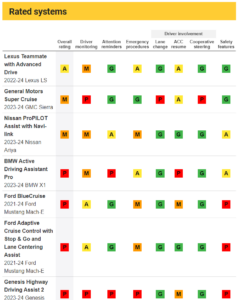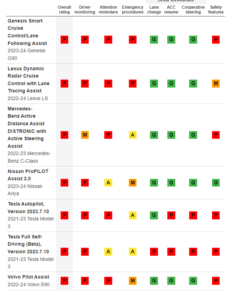The Insurance Institute for Highway Safety (IIHS), an automotive testing organization that has been around for more than half a century, has released its first ranking of semi-automated driving systems. A total of 14 different systems were tested. Eleven were rated poor, two were average, and only one was rated good.
So-called “semi-automated” are not self-driving cars. Drivers are still expected to monitor the road and the system. Drivers must be ready to take control of the vehicle if something goes wrong. These are not advanced driver assistance systems. The IIHS defines them as safety features such as automatic emergency braking, blind spot detection and lane departure warning. “Partial automation is a convenience feature,” IIHS spokesman Joe Young said.
Semi-automated systems use sensors and cameras to relieve drivers of some responsibility for driving the vehicle. These include features such as adaptive cruise control, lane keep assist and automatic lane change. Some even allow drivers to take their hands off the wheel under certain conditions.
The problem is that drivers tend to over-rely on these systems even after a short period of use. And when it’s time to take back control of the vehicle, their reaction time is slower.
“These results are alarming given how quickly vehicles with these partially automated systems are hitting our roads,” said IIHS President David Harkey.
The IIHS tested partially automated systems in 14 vehicles, including popular ones like Tesla’s Fully Self-Driving, GM’s Super Cruise and Ford’s BlueCruise. Only one system was found to be acceptable – Lexus’ Teammate with Advanced Drive. Two were rated mediocre – GM’s Super Cruise and Nissan’s ProPilot Assist. The rest, including BlueCruise and Tesla’s FSD, were rated poor.
There were many reasons, but generally it was found that systems rated poorly were easily cheated and did not retain a driver attention enough. Some of them worked even when the driver was not wearing a seat belt.
The IIHS used several methods to fool these partially automated systems, including covering the driver’s head with gauze to hide the face from in-car cameras and sensors and attaching ankle weights to the steering wheel to simulate the driver’s hands on the wheel.
Source: The Verge


